Did you know scriptures say there are potentially 8.4 Million Yoga Asanas? One for each species in the universe! But thankfully we don’t need to know all of them, for mortals only 84 are relevant. But alas, while names of all 84 are available, they have not all been described in the ancient manuscripts. So, unfortunately, some asanas are lost to us for good, but on the bright side, some are not. And that’s what we will be focusing on in this article. But first, let’s review the basics.
What is Hatha yoga?
Hatha Yoga is an ancient Tantric system of physical practices exclusively designed to raise the Kundalini energy. This branch of yoga is the foundation of all physical asana practices that are prevalent in the modern world. Including Sivananda, Ashtanga, Vinyasa, Kripalu, Jivamukti, Iyengar, Power Yoga – all physical asana practices are derived from the teachings of Hatha Yoga. The primary purpose of Hatha Yoga is to induce deep relaxation and restore balance to the body, so the yogi can sit in meditation. In this process there are four stages:
- Asanas | Postures
- Pranayama | Breathing Exercises
- Mudras/Bandhas | Body Locks
- Samadhi | Deep Meditation
Asanas make us disease free, light, flexible, steady and firm in both body and mind. They make us ready for Pranayama or breathing practices which purify the pranic channels called Nadis. Mudras and Bandhas then help us manipulate shakti or the energy that flows through these channels. And then comes Samadhi which is achieved by concentrating that energy.
Is Hatha Yoga meant for you?
Asanas are a preliminary step that work on the body before the yogi progresses to working on the mind. Hatha is a tantric practice and Tantra believes in transforming and divinizing physical substances before pursuing transcendence. That’s why hatha yoga begins with the body unlike others forms of yoga that begin directly with the mind. For instance, Patanjali’s sadhana begins with very advanced practices involving the mind and subconscious whereas hatha yoga begins with learning how to sit equipoised. It is the difference between learning to stand on one leg and learning to levitate. Hatha yoga is an easier and tangible method to begin our spiritual journey. And because it induces relaxation and calmness, it can beautifully complement any spiritual practice.
Hatha Yoga asanas and their benefits
There are not many surviving texts on Hatha Yoga Asanas. In fact, even though 84 asanas are mentioned we only know a handful of them in detail. For this article, we will go through the teachings of a text called Hatha Yoga Pradipika which gives details about 15 of these 84 asanas. This guide was written in the medieval times by Swami Swatmarama, and he chronicled only those asanas which he considered most important and indispensable for a practitioner.
1. Swastikasana (Auspicious Pose)
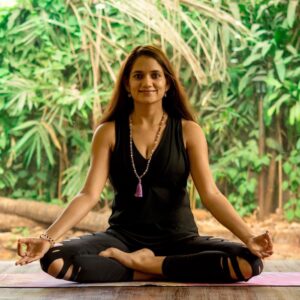 .
.
Swastikasana is a cross-legged meditative position in which the feet go under the thighs on either side emulating the pattern of a Swastika Symbol. This is the first physical posture described in Hatha Yoga Pradipika.
Toes of both the feet are inserted in the gap between the calves and thighs. Adjust the position so that the ankles are not grating against each other. A folded blanket can be placed under the hips to elevate the seat. This makes it easier to bring the bottom foot toes on the opposite thigh. The spine must be straight so nervous impulses can freely travel to the brain.
No specific benefits are mentioned in the text, however, this posture is considered good for the sciatica nerve and regulating body temperature.
The swastika is also the mystical cross symbol of Vedic times – it denotes something auspicious or mark of goodness. An uncanny fact is that various versions of this symbol have been used by different civilizations since antiquity ~ this is considered as one of the symbols common to humanity that arises from our ‘collective unconscious’. Or in other words, it’s a pattern that is known to the unconscious mind which is common to all humanity. In India, it is normally used at the entrance of most houses and even temples. And it is also the first posture chosen by Swami Svatmarama to begin his introduction to Asanas.
2. Gomukhasana (Cow face pose)
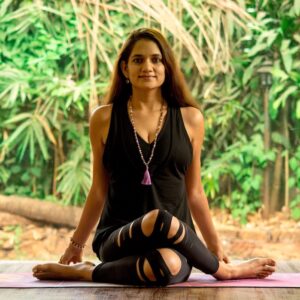
Gomukhasana is traditionally done by locking the fingers of both hands behind the back. However, Hatha Yoga Pradipika verses do not mention anything specifically about the hand position. Typically in Gomukhasana, the hands are clasped behind the back in what is called the infinity formation.
Alternatively, hands can rest on top of the knees or can be placed on the floor ahead for a forward bend. Eyes can be open or closed.
If it is difficult to get legs in this position, start with keeping one leg straight and the other bent in what is also called the half shoe-lace position.
No specific benefits are mentioned in the text, however, this posture is considered good for the reproductive system.
3. Veerasana (Hero’s pose)
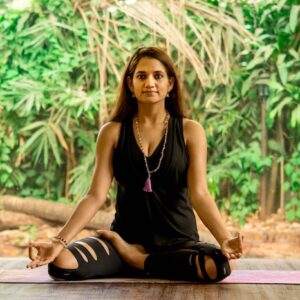
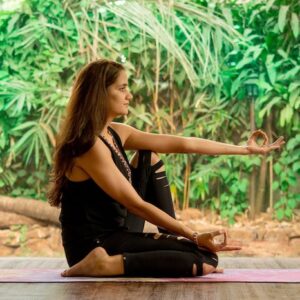
As per Bihar School of Yoga, there are two techniques to do this pose. In the first option, one foot should be bent such that we are sitting on the big toe (like in Vajrasana). The other foot can be placed over the opposite thigh (like in Ardha Padmasana) with the knees wide and hands in a meditative mudra. Alternatively, we can simply bend the knee and rest our elbow on it, as shown in the second photo.
No specific benefits are mentioned in the text, however, this posture is a great alternative meditative position for beginners. Especially those who have trouble sitting in a cross-legged position can start with this.
4. Kurmasana (Tortoise Pose)
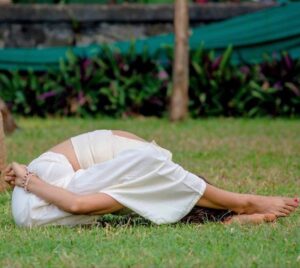 .
.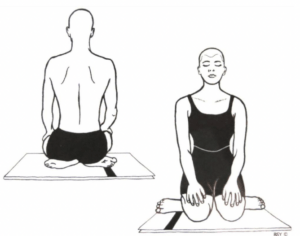
Hatha Yoga Pradipika gives a very different explanation of Kurmasana compared to what we are used to seeing. Typically Kurmasana is practiced as shown in the first photo – facing down with our head between our legs and arms in a bind (refer to the first image). However, the verses in Hatha Yoga Pradipika define it as shown in the second photo (Image credit: Bihar School of Yoga). The first position is called Kurmasana because the body resembles a tortoise. But the second posture is called Kurmasana as it activates the Kurma Nadi – a subtle energy channel.
The second version is similar to Vajrasana except that the feet are everted – instead of sitting on the toes we are sitting on the heels with toes pointing out. The knees are close together.
No specific benefits are mentioned in the text, however, this posture is considered good for improving energy and vitality in the body.
5. Kukkutasana (Cockerel Pose)
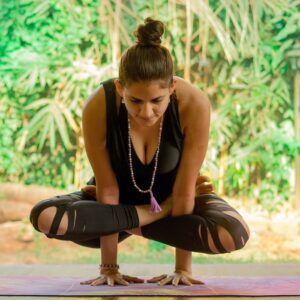
Kukkutasana begins with Padmasana, hence should only be practiced if we are very comfortable in the lotus posture (discussed below). Once in padmasana, slide the hands through the gaps between the legs as far back as possible. Lean forward and lift up onto the palms. The hips are off the groups and palms should be placed firmly on the floor with fingers wide, pointing forward. Weight should be balanced on both hands equally and lift off while inhaling. In the beginning, you can oil or water (after rolling up the leggings) to reduce friction while sliding the hands.
No specific benefits are mentioned in the text, however, this posture is said to help raise Kundalini energy as it imitates levitation.
6. Uttanakoormasana (Stretching Tortoise Pose)
The picture shown is a variation of the actual pose.
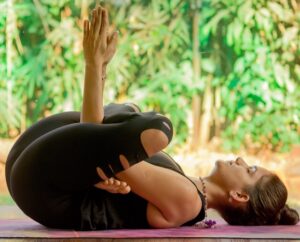
Uttanakoormasana is the lying down variation of Kukkutasan. Sit in padmasana and slide the hands through the legs like in the previous posture. If you can, try and grab the ears with the fingers and roll back to lie down on the floor. This posture should be practiced only after learning Kukkutasana. In the final position, hands can either touch the shoulders or interlock behind the neck.
No specific benefits are mentioned in the text, however, this posture is considered great for relaxing and calming the nerves.
7. Dhanurasana (Bow Pose)
The picture shown is a variation of the actual pose.
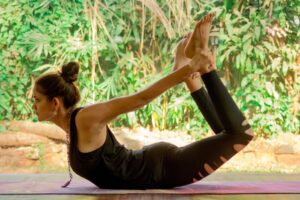
Dhanurasana literally strings the body like a bow. The Hatha Yoga Pradipika mentions that the toes are held with the hands and pulled up to the ears just like a warrior draws his bow before releasing the arrow.
This posture has many progressive variations and if it’s difficult to hold the toes then it can be practiced by holding the ankles. If it’s difficult to lift up in this position we can practice lifting only the knees five times and then the chest five times. Slowly start combining both movements.
Breath can either be retained internally in the final position or normal breathing is done. Exhale while coming down.
No specific benefits are mentioned in the text, however, this posture is considered excellent for the digestive and eliminatory system. Because it opens up the chest and shoulders it improves breath capacity and helps in chest ailments.
8. Matsyendrasana (Spinal Twist Pose)
The picture shown is a variation (Ardhamatsyendrasana) of the actual pose.
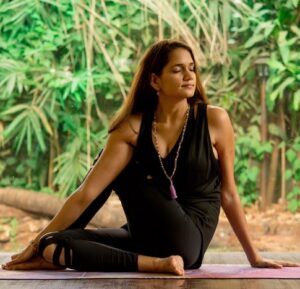
This posture is so named as Sage Matsyendranath was said to practice this pose. There are different variations of it and the one shown in the picture above is called Ardhamatsyendrasana or half spinal twist. I’ve shown two version, with and without the bind (Binding is not important and it is also a function of body proportion which can vary by ethnicity.). In the final version of Matsyendrasana, the foot of the bent leg is placed in half lotus position and not on the floor. It is a very advanced posture and should be done under guidance.
The text goes on to say that practicing this posture increases the digestive fire so much that it burns away all diseases and wakes up the Kundalini energy. Which in turn brings equilibrium to the ‘Bindu‘.
What is Bindu?
Bindu is representative of hormonal fluids secreted by the pituitary and pineal glands, also known as Soma. It drips down from the head and burns away in the digestive fire. If we can prevent this fluid from falling and wasting we can gain vitality and longevity.
9. Paschimottanasana (Back Stretching Pose)
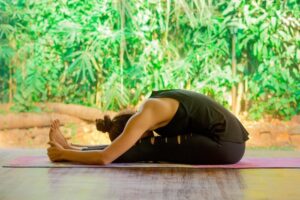
Paschimottanasana is like touching our toes but while sitting on the floor. It is important to bend forward from the hips and not the spine. Often if the hamstrings are tight, we overarch the back instead of stretching the legs. A good way to avoid this is by slightly bending the knees and trying to get navel down rather than the forehead. Also, ensure that the head does not go too far forward out of alignment. The bend should come from the hips. Breathe normally or retain the breath internally. Inhale to come up.
The text endorses this posture as one of the best asanas which gives a flat stomach and increases the digestive fire. It also helps the pranic energy rise efficiently.
10. Mayurasana (Peacock Pose)
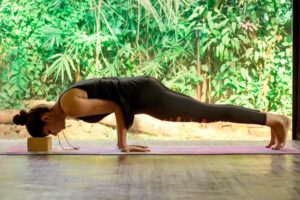
Mayurasana is a powerful position with many benefits. I’ve done a beginner variations here using a prop. Place a block in front of you and the elbows on either side of the waist and stretch the legs back one by one. Lower the body down and rest the forehead on the block. Work on lifting the alternate leg off the floor one by one. Once you’ve developed the strength work on lifting the forehead. Ensure that the wrist joint, neck and spine are not in pain or discomfort.
The most important benefit given in the text is that it digests all types of food and increases the digestive fire to such an extent that even the deadliest poison is destroyed. This is symbolic of a peacock who can eat a poisonous snake. It also balances our doshas (Vata, Pitta, Kapha) which when vitiated can cause many diseases.
Note: Mayurasana can be very intense on the female reproductive system and individual precautions should be taken while practicing it.
11. Shavasana (Corpse Pose)
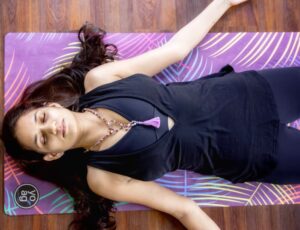
Shavasana is a very relaxing posture that can even penetrate our subconscious. In the final position hands and legs should be separated and palms turned up. The entire body should be aligned in a straight line and not crooked. Relax each part of the body by ignoring the mental chatter and keeping the focus on the breath
Shavasana helps us remove any tension and reset our body and mind. Often we tend to skip it, but it is very important to make time for these moments of peace and stillness.
No specific benefits are mentioned in the text, however, this posture is great for anxiety, stress and heart issues.
12. Siddhasana (Adept’s Pose)
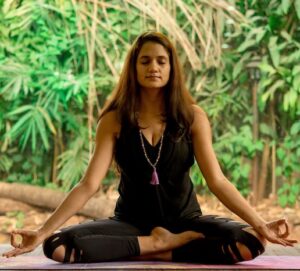
Siddhasana is a very powerful meditative posture and is considered the best pose for higher meditation. In it, the toes of both feet are inserted between the thigh and calf muscle like in Swastikasana (covered earlier). This asana differs from Swastikasana in heel placement ~ the heels are almost stacked on top of each other and we’re almost semi sitting on the bottom heel. The foot will need to be turned up and adjusted so ankles don’t come in the way.
Hatha Yoga Pradipika declares it to be the best posture for meditation, even better than Padmasana. The author of the text encourages the practitioners to do it daily and even states that if practiced regularly for twelve years it can result in siddhis or superpowers.
13. Padmasana (Lotus Pose)
The picture shown is a variation of the actual pose.
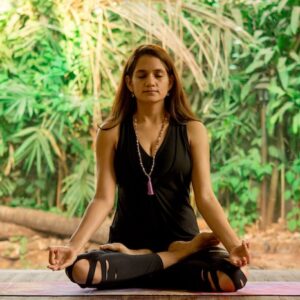
Padmasana is the most common and popular meditative posture. However, the posture as described in the Hatha Yoga Pradipika is Baddha Padmasana, with hands going around the back and holding the toes. In this posture, the tongue should be pressed against the roof of the upper teeth which is said to create a pranic circuit in our body. Even though this is the most popular meditative posture of our times, it is Siddhasana which is considered more useful. Care should be taken in its practice as it is also a leading cause of injury to knees and ankles; mostly due to impatience (Rajas Guna!).
The text goes on to describe some kriyas which can be done in padmasana which give the yogi the highest knowledge by awakening the Shakti or Kundalini.
14. Simhasana (Lion Pose)
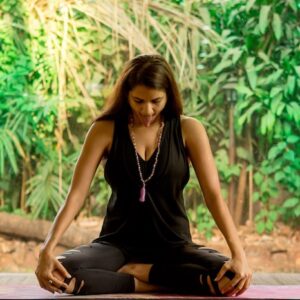
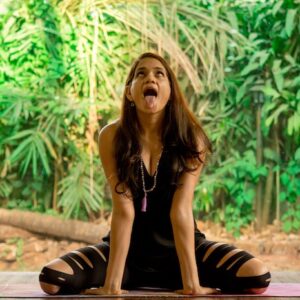
Bihar School of Yoga gives two ways to do this asana ~ The first one is as described in Hatha Yoga Pradipika and the second one is a more common version called Simhagarajnasana or Roaring Lion Pose. In the latter, the sitting position is same as Bhadrasana (which is covered next). In the crossed leg variation the chin is lowered to the chest and drishti is at the nose tip. In the other variation, the chin is raised up and drishti is at the eyebrow center. Extend the tongue as far out as possible and while exhaling make a roaring sound like a lion. Sound should not be forceful, nor should it irritate the throat.
No specific benefits are mentioned in the text, however, this posture is considered good for stammering or throat issues.
15. Bhadrasana (Gracious Pose)
The picture shown is a variation of the actual pose.
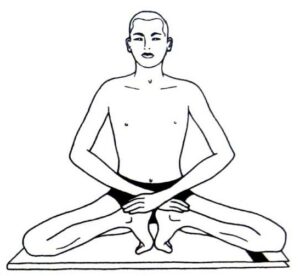
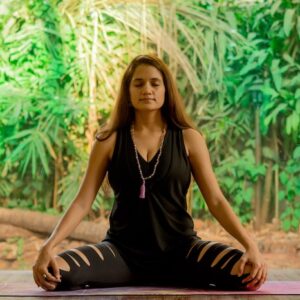
Bhadrasana is the last posture or Asana described in the Hatha Yoga Pradipika. It is an advanced Asana and requires careful practice. Traditionally, in this pose, one should be sitting on the ankles with heels together or turning the feet such that heels are facing upwards. I’ve demonstrated an easier variation which can be practiced comfortably and also shared the image of actual asana (Image credit: Bihar School of Yoga). For the easier variation, sit in Vajrasana and separate the knees as wide as possible. Try to place the big toe underneath the buttocks and heels as close to the body as possible. Place the hands on the knees and close the eyes to attain a meditative state.
No specific benefits are mentioned in the text, however, this posture is said to give some of the same benefits as other meditative postures.
Swami Svatmarama goes on to say in the next verse that one should feel an energy boost after asana practice and not fatigue. If feeling tired, then it would mean the practices are being done incorrectly. After Asana and Bandhas one should practice Nadi Shuddhi, Mudras and Pranayama. In the concluding verses, he guides the yogi on the ideal diet and lifestyle to attain perfection in Raja Yoga. This concludes the first section of Hatha Yoga Pradipika on ‘Asanas’.






